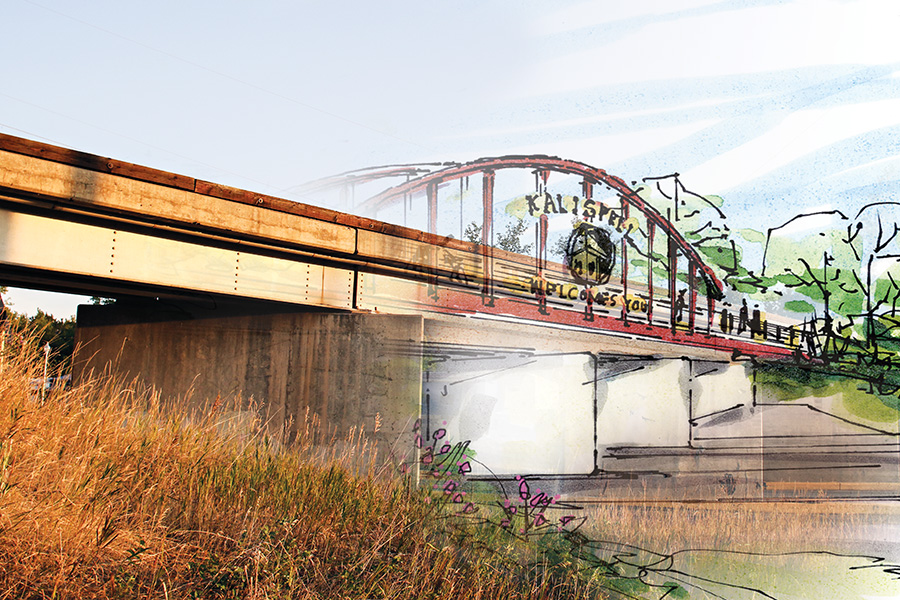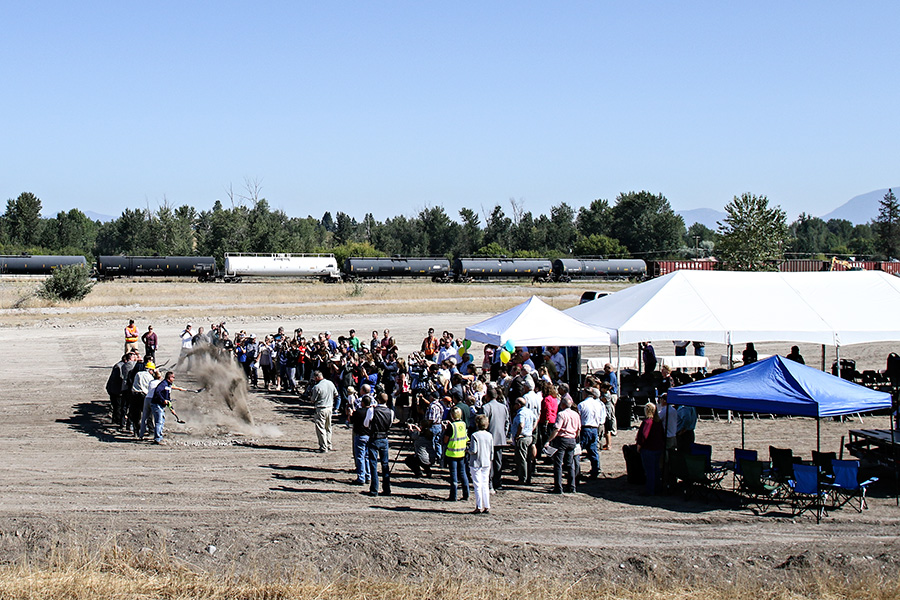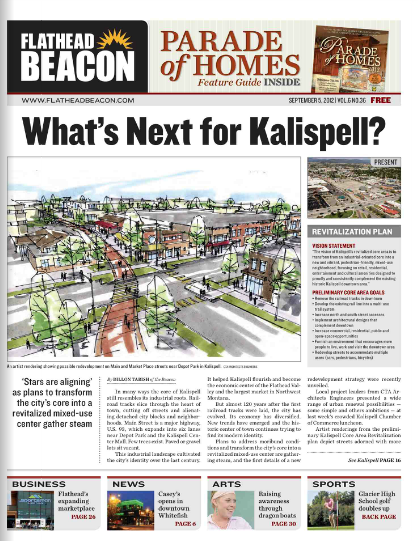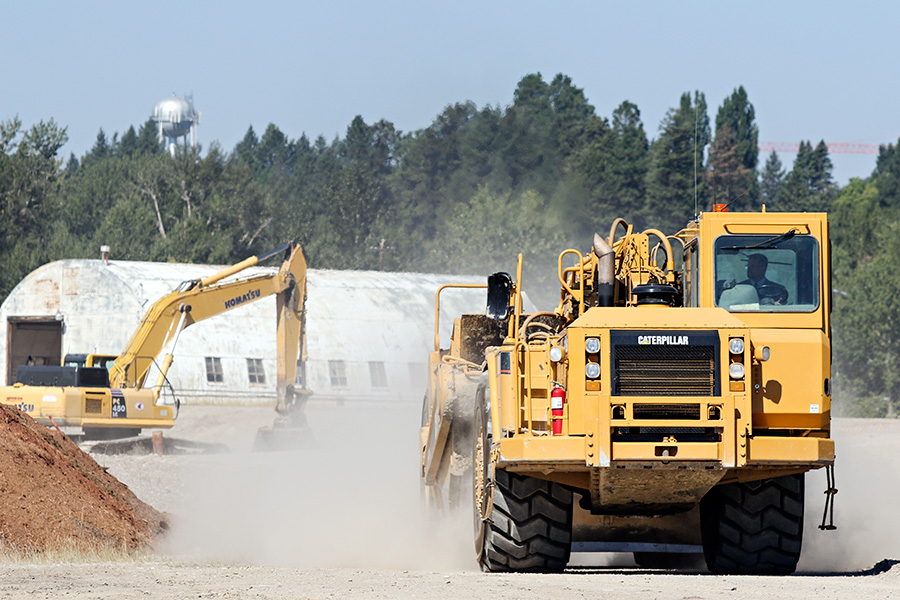A City’s Path Forward
With the groundbreaking of a long-awaited rail park, Kalispell’s ambitious vision for a revitalized core area is coming into focus
By Dillon Tabish
“This is truly a transformative moment,” Kalispell Mayor Mark Johnson said last week, speaking to more than 200 people gathered in a dusty, wide-open lot tucked along the eastern outskirts of town.
“This is the moment in history 50 years from now we will look back on and realize the pain and sacrifices we made were well worth the effort.”
The bold declaration on Aug. 22 set the stage for a groundbreaking ceremony several years in the making, following countless public and private meetings. It also set the tone for a seismic event that could reverberate across Kalispell and dramatically reshape the landscape in the years to come.
The Glacier Rail Park is surfacing. A day after the mayor’s remarks, Kalispell-based construction firm LHC officially began developing the 40-acre property between Whitefish Stage Road and U.S. Highway 2 into a centralized railroad hub for the entire Flathead Valley.
The former McElroy-Wilkins gravel pit is playing a pivotal role in a much larger vision: a community revitalization plan that aims to redevelop public infrastructure and attract private investment in the core area of Kalispell.
“The rail park is the first step in the transformation of downtown Kalispell. The rail park is the key cog that allows us to move forward and reclaim that part of town,” Johnson said. “Rails were what made Kalispell and created our town. We are now moving on to a new direction and creating a new vision for downtown Kalispell and creating a new vision for rail use in Kalispell, Montana.”
Among the crowd who arrived to celebrate the historic groundbreaking were U.S. Sen. Jon Tester and administrators from a large lineup of state and federal agencies, as well as BNSF Railway, all echoing Johnson’s sentiments and applauding Kalispell’s collaborative strategy.
“This is a great example of what can happen when we all work together, whether we’re in federal, state or local government, or private industry,” Montana Department of Transportation Director Mike Tooley said. “If that had not happened, we would not be here today. Kalispell gets it done.”
Flathead County Economic Development Authority began devising the rail park nearly a decade ago and acquired the land in the spring of 2012 with the help of $1.14 million in federal funds. At the same time, the city of Kalispell began collecting community input to craft a strategy for revitalizing the historic core area once the railroad tracks were relocated.
In the years since, instead of gathering dust, the two projects simultaneously gained momentum. On its third attempt, the city successfully landed a $10 million federal transportation grant that is fueling development of the rail park, and a year ago celebrated the completion of the U.S. Highway 93 Alternate Route, a separate yet similar project that is also creating cascading change in one of Montana’s fastest-growing cities.
“I have no doubt that the $10 million that we’re investing in this community will bring millions and millions of dollars in economic growth to Northwest Montana,” Tester said. “Not only will this new rail park add to the appeal of an already booming area of Montana, but new businesses will have the opportunity to expand into downtown Kalispell.”

What’s Next?
LHC will construct the rail park infrastructure over the next 12 months with a tentative completion date set for August 2018.
In the meantime, the city of Kalispell has plenty of details to iron out, including the design of a new two-mile linear park, or trail system, that will replace the downtown railroad tracks and decisions on which streets to reconnect, such as a potential extension of Woodland Avenue to Highway 2.
The completion of the rail park will allow several changes to occur.
For starters, it will open the door to the site’s first two tenants — CHS Kalispell, formally Cenex Harvest States, and Northwest Drywall, the two businesses using the current tracks.
CHS General Manager Mark Lalum says the goal is to begin relocating the company’s operations to a new facility in the rail park by next fall.
FCEDA, the owner of the rail park, has agreed to build a new facility that CHS will lease in exchange for the company’s three properties: the 3.81-acre fertilizer plant and gas station on Third Avenue North near Smith’s; the 1.6-acre grain elevator site on West Center Street; and the 41,000-square-foot gas station and office on West Idaho Street.
FCEDA will clean up and sell the three properties, according to Kim Morisaki, FCEDA project manager.
ImagineIf Libraries, the county public library, is considering development of a new facility at the Third Avenue North site to replace its aging structure in downtown. The ImagineIf Library Board of Trustees is still figuring out the details of any potential facility construction, which would require a voter-approved bond.
Lalum said CHS’s new centralized facility in the rail park will help the company expand and improve its operations, which will benefit agriculture producers across the region that utilize CHS for distribution.
“This is exciting for everybody,” Lalum said at the groundbreaking ceremony.

“We will be able to upgrade some of our facilities to better handle the capacity of what’s going on. Our facilities were designed for farming 50 years ago. This will give us the capacity and capability to keep up with the technology and speed they are going at now.”
Once CHS and Northwest Drywall are settled into the rail park, the historic tracks slicing through the heart of Kalispell will be essentially rendered useless. BNSF Railway has started the abandonment process of that section of line and remains in negotiations with the city of Kalispell on a deal to transfer the property.
“We’re trying to finalize it and wrap it up to where we’re meeting the interests of both parties,” Doug Russell, Kalispell’s city manager, said of negotiations with BNSF.
The ultimate goal is to replace the tracks with a so-called linear park, which could include a landscaped trail system connecting the west and east sides of town. The goal of the trail system is to improve walkability, which residents have increasingly wished for in the core area, according to city officials and planners.
“The design of the (core area revitalization plan) was driven by simple urban design principles of walkability and letting the pedestrian safely and easily move around,” said David Koel with CTA Architects Engineers, the local firm that crafted the original core area plan five years ago.
The trail system might just be an asphalt path but could have a much larger ripple effect.
The plan envisions a pedestrian pathway that winds through the heart of town, connecting Woodland Park, downtown, the mall, neighborhoods and retail destinations.
“The whole idea behind a good urban plan is to get density,” Koel said. “Permanent residents will live there, shop there, eat there. That type of environment provides viability for businesses and energy for the whole town.”
Density — allowing for mixed-use properties, such as residential and retail, restaurants and coffee shops in a relatively confined area — may seem unattractive in a rural haven like the Flathead Valley, but Koel said it actually helps preserve the greater character of this community.
“I love the Flathead Valley, but I’ve noticed that we’ve continued to sprawl,” he said. “We’re eating up our beautiful landscape.”
“We need to grow, but it would be nice if we could do it smartly,” he added. “If we can get more and more people in less and less area, it’s going to have a really good effect on the city but also take some weight off the rural community.”
Russell said the city will re-engage with the community to begin designing the specifics of the trail system and other elements of the core area revitalization plan.
“Now we get to start working on what that trail will look like,” he said.
The goal is to remove the railroad tracks in 2019 and begin developing the trail. The removal of the tracks will also allow the city to reconnect an array of disjointed streets that have been cut off and become blighted in some areas.
“It’s amazing to think about the influence that the rail has had in this community, but we feel a little out of touch with that,” said Katharine Thompson, Kalispell’s community development manager.
“Now we get to have that important industrial access for businesses and be able to diversify, not just Kalispell but the entire county, with access to rail in a way we don’t right now. It also will turn around the center of Kalispell, the heart of downtown. We are going to transform Kalispell and make it what our community wants it to be.”

Will It Work?
When Kalispell’s core area revitalization plan debuted five years ago, it was met with overwhelming excitement. But skepticism remained: When would these great changes actually emerge?
Now the first and most important parts of the chain reaction are officially underway. And yet a new skeptical question quietly lingers: Will these public projects — a trail system, reconnected streets — actually spark significant private investment and redevelopment?
According to local planners and urban development leaders in other cities, the answer seems to be clear: Yes.
Missoula is in the midst of a massive makeover in its core area. Developers are preparing to break ground on a new $150 million project that will include a 29,000-square-foot convention center, 200-room hotel and underground parking garage, trails and retail space. The project, called the Riverfront Triangle, is a unique partnership between the city and private developers that includes funding through a tax-increment finance (TIF) district. The development is emerging in the wake of the city’s infrastructure investments over the last two decades, such as a trail system and refurbished streets.
“The parks and trails have been a huge catalyst in downtown,” said Ellen Buchanan, director of the Missoula Redevelopment Agency.
“When we started building the trail system and Caras Park and all the other parks along the (river) bank, it just totally transformed Front Street. Those things have ripple effects. With Riverfront Triangle, we used TIF money to purchase 3 acres of property and used that as an enticement to bring in private developers.”
Buchanan said the “creative partnership” between the city and developers proved successful because neither side could single-handedly bear the brunt of redevelopment.
“It’s not realistic for a project like that to do it alone,” she said.
Through the city’s downtown planning and investment, an array of other development is emerging, including mixed-use apartment/retail buildings.
“What’s worked best for Missoula is that we try to be as creative as we can be to make these complicated projects happen,” Buchanan said.
![]() “We’re fortunate to have an excellent city council that understands that Missoula is going to grow. We can either influence or guide the growth or let it roll over top of us. And I think Kalispell is in the exact same position.”
“We’re fortunate to have an excellent city council that understands that Missoula is going to grow. We can either influence or guide the growth or let it roll over top of us. And I think Kalispell is in the exact same position.”
Private investment has indeed already emerged in Kalispell’s core area.
One of the most prominent property owners — Kalispell Center Mall — is taking advantage of the momentum created by the core area revitalization plan by finishing a 40,000-square-foot addition to Herberger’s. A new brewery is in the works adjacent to the mall and Main Street.
Eric Peterson, property and leasing manager of the mall’s owner, Goodale & Barbieri Company, announced this week that SunRift Beer Company has signed a new long-term lease in the former Alano Club building north of the Kalispell Center Mall along the railroad tracks just off Highway 93.
“We are extremely excited to have this opportunity,” said Craig Koontz, the lead brewer and proprietor. “The historic beauty and setting of this development area is second to none, and we are honored to be a part of celebrating downtown Kalispell and participating in the core area of the Flathead valley community.”
More growth is potentially waiting in the wings, too.
“We have had renewed interest in the downtown core, including the Kalispell Center Mall, due to the rail park as well as the neighboring trail,” Peterson said. “Herberger’s is almost complete with doubling their size, showing significant commitment to downtown Kalispell with such a large investment. We have been encouraged by interest from tenants not currently located in the Flathead area. North of the tracks, we have signed one lease with an exciting user yet to be announced, and also have interest from a larger user.”
Johnson, Kalispell’s mayor, said the key to success of the revitalization effort will be the city shepherding positive development but at the same time letting business growth unfold naturally.
“The best step we can take is to get out of the way of private enterprise,” Johnson said. “We’ve created the vision — now we need to create the groundwork and make it attractive for people to come in and redevelop.”
The city has recently redesigned some of its zoning standards in the core area, such as altering parking and height restrictions.
“How do we ease regulations but keep them in the spirit of what we need to do?” Johnson said. “How do we make it easier and how do we entice the growth? That’s what we need to focus on.”
Kalispell’s historic center faces challenges in that regard. Aging infrastructure is never cheap to replace, and the age-old debate over who should pay for new development — specifically in the form of impact fees — remains a hot topic. Johnson predicted the city council would seriously consider reducing impact fees that place a sizable portion of the financial burden on developers.
There’s also the heated debate over what should happen to Main Street, which doubles as U.S. Highway 93. Should it remain four lanes through downtown or be reduced to two lanes and a center turn lane?
The city of Kalispell would like to reduce traffic on Main Street and allow for wider sidewalks, fostering the improved walkability that is considered central to redevelopment. Yet the Flathead County Commission has sided with MDT in opposition to reduced traffic lanes on Main Street.
In a letter submitted to the city earlier this month, the three commissioners wrote, “This north-south route through Flathead County and Kalispell is vital to county citizens commuting through the Kalispell area for work or shopping. The proposed change to a two-lane travel corridor in the Kalispell downtown will impact both local citizen commuters and tourists, requiring them to avoid this route by using other routes or urban streets to get around the downtown, adding time and safety concerns to commutes.”
County roads such as Willow Glen would see increased traffic under this scenario, county commissioners said.
The city’s Technical Advisory Committee agrees on the added pressure facing Willow Glen and recently named the road a critical project requiring potential changes. The TAC board has asked MDT to provide cost estimates for potentially upgrading Willow Glen into something like an east-side bypass route.

‘The Cascade Has Started’
While sizable decisions remain, the momentum of the core area revitalization plan is real.
“The cascade has started,” said Tom Jentz, Kalispell’s planning director.
Koel with CTA added: “It comes down to a rare opportunity to rebuild the core of our community. It’s rare. We have to take advantage of it fully.”
At last week’s groundbreaking ceremony, any thought of potential challenges and prospective debates were publicly absent. Energy and excitement defined the mood.
Clutching a shovel with one of the first piles of fresh dirt at the future rail park, Mayor Johnson exclaimed, “We’re going to start the transformation of downtown Kalispell right now.”
_______________________
Redeveloping Kalispell’s Core Area
Potential changes in the heart of the city
1.Glacier Rail Park
The 40-acre site between Whitefish Stage Road and U.S. Highway 2 is being constructed into an industrial rail park, which will house new rail-served facilities for CHS and Northwest Drywall, as well as potential future users. The development of the centralized rail park will allow the city to remove the tracks that cut through downtown.
2. Downtown Linear Park and Trail System
A two-mile trail system and “linear park” will replace the historic railroad tracks slicing through the heart of Kalispell. The pedestrian and bike trail will travel from a new bridge “gateway” over U.S. 2 and run west through downtown before adjoining with the bypass trail system and Great Northern Historic Trail, creating a network connecting Somers, Kila and Kalispell.
3. Improved Walkability
Streets such as Center Street could receive sidewalks and boulevards for the first time while existing sidewalks along streets such as Main could see expanded paths that improve safety and walkability.
4. Higher Density Residential
There are limited opportunities for residential living in the core area but that could change with entire city blocks being made available with redevelopment efforts. Areas that have been cutoff by splintered streets are becoming prime property for high-density development, such as housing and retail.
5. Fine Arts Center or Future Library?
The ImagineIf Library board of trustees is studying plans that call for building a new facility. One location being considered is the CHS property on Fourth Avenue East North across from Smith’s. CHS will relocate all of its facilities to the new industrial rail park and the former property will be transferred to Flathead County Economic Development Authority. Preliminary plans also encourage the creation of a fine arts center or convention center.
6. Connect Disjointed Streets
The railroad tracks have created disjointed streets throughout the heart of town, cutting off potential development and creating blighted or underutilized properties. By removing the tracks, the city plans to reconnect several streets that will improve transportation and open up an estimated 14 acres of underutilized land that will now be ripe for redevelopment.